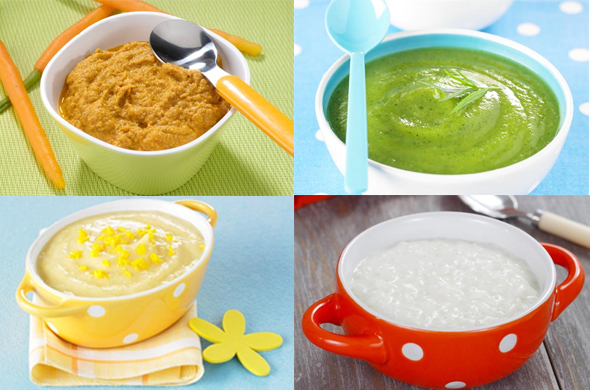Good weaning foods for babies
Ultimate Guide to Baby Led Weaning (and Best First Foods)
Learn the basics of how to do the feeding approach known as “baby led weaning” and the best first foods for baby to make starting solids easy and fun. Plus: Learn why it’s perfectly okay to use a combined approach of blw and purees.
Baby Led Weaning
The feeding approach known as “baby led weaning” or “BLW” for short, is a style of feeding infants that allows them to feed themselves right from the start. The food is offered in thick finger-size pieces and is soft and easily squishable between your fingers. This way, the food is both easy to hold but has a low risk of choking.
TIP: This method became popular about a decade ago after the publication of the Baby Led Weaning: The Essential Guide to Introducing Solid Food by UK author Gill Rapley.
BLW Baby
One of the many reasons that people are starting to opt for this style of feeding more and more is simply that it’s easy. In many cases, you can modify foods you’re already making to share with your baby and there’s not always a lot of separate cooking involved. It also allows a baby to have control over what goes into their mouths, which sets a good precedent for letting them eat intuitively from the start.
What age should I start baby led weaning?
According to the American Academy of Pediatrics, a baby is ready to start solids with baby led weaning when:
- They’ve doubled their birth weight (at least).
- They can hold their head up well and are starting to sit up unsupported.
- They show signs of being interested in food (watching you eat, reaching for food when you’re eating, etc).
- When you feed them, they are able to move the food around in their mouths—rather than spit it right out.
TIP: Look for a highchair that allows a baby to sit up relatively straight so they can have good posture and better control over their arms and hands.
How to Start Baby Led Weaning
The first time you offer solids is such a fun milestone, so you’ll be ready once you follow these simple steps.
- Make sure baby has hit the milestones listed above to let you know that he’s ready to start.
- Get the highchair ready and adjust the straps and foot rest as needed.
- Plan to introduce water when you start solids. I recommend a trainer cup.
- Choose one food to start with and plan to offer only one food at a time.
- Stop when baby starts to fuss, turns his head away, or shows any other signs of not wanting to continue. It’s usually fairly obvious when they are done!
TIP: If you start offering solids and baby just doesn’t seem interested at all, it’s okay. Take a break for a few days or a few weeks and start again. Each kiddo has their own unique timeline.
Best Tips for Starting BLW
Here are a few more tips to consider and review before you get started.
- Understand the gag reflex. Gagging is different than choking though and is most often a sign that baby is learning to move food around in their mouths—and to get it out of their mouths, which is a skill you want them to have!
- Brush up on the basics of how to know when baby is ready to start solids. (Go back to the top of this post for the signs to look for.)
- Set them up for success with a highchair that allows them to sit up straight and has foot support.
- Sit with them as you offer food.
- Check your own expectations of what will happen and simply allow your baby to take the lead.
- Start with one new food a day or every few days.
- Vary the textures of foods you offer to start exposing baby to many right from the start.
- Offer water in a sippy cup or small open cup.
TIP: Remember that breastmilk or formula will continue to satisfy baby’s hunger for the first few months of eating solids. Do not expect solids to replace milk feedings at this age.
First Foods for Baby
Starting solids with baby led weaning or purees are both perfectly acceptable ways to introduce a baby to solid foods—but the topic can get so heated! There’s a lot of pressure to do it the “right” way and I’m here to say that there isn’t one. You 100% can do one or the other, or combine the two to make it work for your family. It’s all good!
Remember, the goal with first foods for baby is that they’re introduced to flavors, nutrients, and foods they can easily eat or suck on. It should be an enjoyable milestone for all involved.
TIP: It’s a good idea to get into the habit of offering an iron-rich food since iron stores in babies start to run out around 6 months and they’ll need to start ingesting it in their food.
Best First Foods for Baby Led Weaning
Here are some of our favorite first foods to offer baby led weaning style. You want foods to be finger sized so they are large enough that baby can’t force the whole piece into their mouth, and a shape that’s easy for a 6 month old to hold with their chubby little hands. These are some of our favorites.
These are some of our favorites.
- Roasted sweet potato wedges
- Roasted apple wedges, skin on to help them hold together
- Roasted or steamed broccoli florets (big enough for baby to hold)
- Melon slices
- Thick mango slice
- Banana with some of the peel still on
- Toast sticks with mashed avocado
- Avocado spears (make sure the avocado is ripe and soft)
- Lamb or beef, on the bone or a large piece for baby to suck on
- Dark meat chicken, on the bone or a large piece for baby to suck on.
TIP: The foods should generally be soft enough to squish between your fingers with the exception of the large pieces of meat. If baby gnaws a piece down into a smaller piece, replace it with a larger one to avoid her putting a chunk of food into her mouth.
Baby Led Weaning Banana
To serve a banana to a baby, wash it well, then slice it in half. Cut off an inch or two of the peel, but leave the rest of the peel on so it’s not slippery for baby to hold. They’ll suck on the top part like a little popsicle! You can also help them hold the banana if needed.
They’ll suck on the top part like a little popsicle! You can also help them hold the banana if needed.
Foods to Avoid Serving While Doing BLW
You want any foods you offer to a baby while doing baby led weaning to be soft enough to squish between your fingers and safe for them to eat and digest. Plan to avoid:
- Anything hard, sticky, or crunchy (like raw apple or carrot, whole nuts, crackers, or a big spoonful or nut butter)
- Added salt
- Cow’s milk (which is difficult for kids under 1 to digest; plain yogurt is fine though)
- Added sugar (they simply don’t need it)
- Honey (to avoid a risk of botulism)
- Super slippery foods that would be hard for baby to hold (which can be frustrating)
TIP: Always sit with your baby and watch them try to eat. They are your best guide for making adjustments to the foods you serve.
Baby Led Weaning and Choking
There are many parents who dislike this method of feeding because it often sounds like a baby is choking.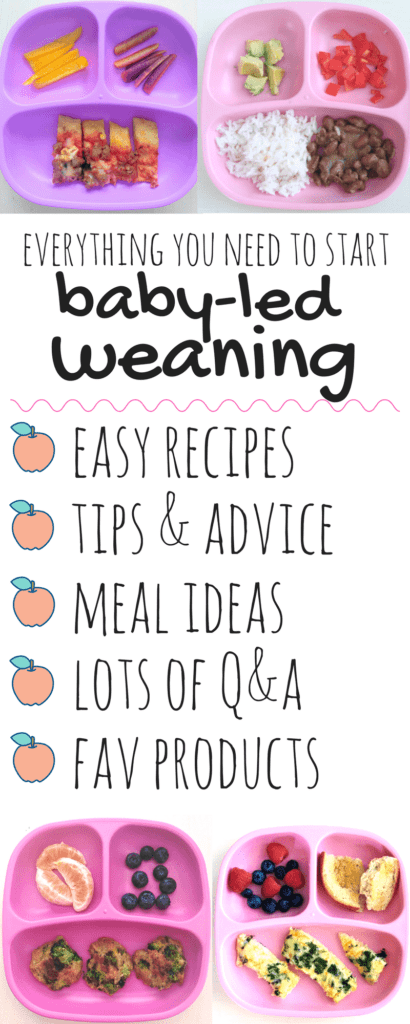 And while there are surely some incidences of choking, what’s more likely is that a baby will occasionally gag on a piece of food that gets into their mouth that they weren’t expecting.
And while there are surely some incidences of choking, what’s more likely is that a baby will occasionally gag on a piece of food that gets into their mouth that they weren’t expecting.
But remember: Gagging is a sign that baby is doing what she needs to in order to move the food around in their mouth as they learn to eat. It usually sounds more dangerous than it actually is.
TIP: If the sound of gagging really freaks you out, you’re not alone. Consider offering more preloaded spoons with purees to start your journey more slowly.
How to Cut Foods for BLW
You generally want the food to be big enough that it would be difficult for baby to put the entire thing into their mouths. Here are some specifics:
- Foods that are roughly the size of a finger, so about a 4-inch stick.
- Foods that are easy for the baby to pick up—they can’t pick up small pieces until closer to 9 months when they develop the ability to use their fingers in what’s known as a “pincer grasp”.

- Foods that aren’t too slippery—so you can wash and leave some of the peel on fresh foods like bananas, avocado, kiwi, and mango.
TIP: You can also go even bigger if you’re worried about size. Think half of a slice of bread or a big chunk of watermelon.
Will my baby actually eat much food with BLW?
Probably not at first. There will likely be more tasting of the food than eating of it and that is totally fine. They will still rely on breast milk or formula at this age for their main nutrition, so don’t expect them to suddenly start eating full meals. (They’ll get there in a few months, but it takes time!)
Do babies need teeth for baby led weaning?
No! Gums are super strong and front teeth aren’t used for chewing—that happens when the back molars come in. Teeth really have nothing to do with whether or not a baby can eat solids.
TIP: Learn more about what to expect from teething here.
Can you mix baby led weaning and purees?
Absolutely! I think it’s a great idea to mix the two methods simply because it gives you many more options for foods and allows the baby to experience more textures. I recommend allowing babies to feed themselves preloaded spoons—so you put the puree on a spoon, then hand it to them to actually put the spoon into their mouth—so they still have control over what goes into their mouths.
I recommend allowing babies to feed themselves preloaded spoons—so you put the puree on a spoon, then hand it to them to actually put the spoon into their mouth—so they still have control over what goes into their mouths.
TIP: Feeding some purees is also helpful if you’ll be sending food with a baby to daycare since the care provider may not have experience with blw.
Best First Foods for Baby: Purees
Here are some of our favorite purees to start offering baby when they’re ready to start solids. Remember: There’s no evidence that says that you need to start with vegetables versus fruits, so go with something that tastes good to you. Start with single foods pureed smooth and offer just a little at a time on a spoon.
- Mashed roasted sweet potato puree
- Mashed avocado puree
- Mashed banana puree
- Butternut squash puree
- Applesauce, unsweetened
- Mashed pea puree
- Oatmeal baby cereal (with added iron)
TIP: One of my favorite baby food companies is Amara Organic Baby Food, a company using a nutrient protection technology that makes organic purees just as good as homemade. I love how easy they are to use when I need a shortcut and that they have fun baby-led weaning recipes on the side of every box! (paid affiliate link)
I love how easy they are to use when I need a shortcut and that they have fun baby-led weaning recipes on the side of every box! (paid affiliate link)
How do I know when baby has had enough?
If your baby is eating and then starts to turn her head away or just refuses to open her mouth, she’s done! Babies may also start to fuss if they’ve had enough. Learning this new skill takes time and babies can become tired fairly quickly into the process, so don’t expect them to always eat very much or to last very long at the table. This stage is about exploration!
Baby with preloaded spoon of yogurtHow to Let Baby Self Feed Purees
I love offering purees on a preloaded spoon. To do this, the parent, puts some of the food on the spoon and hands it to baby. Then baby can bring the food to their mouth all by themselves. This gives you some of the same advantages of baby led weaning, but can be more comfortable for many parents.
Remember, you can mix what you offer, going back and forth between purees and blw finger foods, so you can offer the same food two different ways to let baby explore.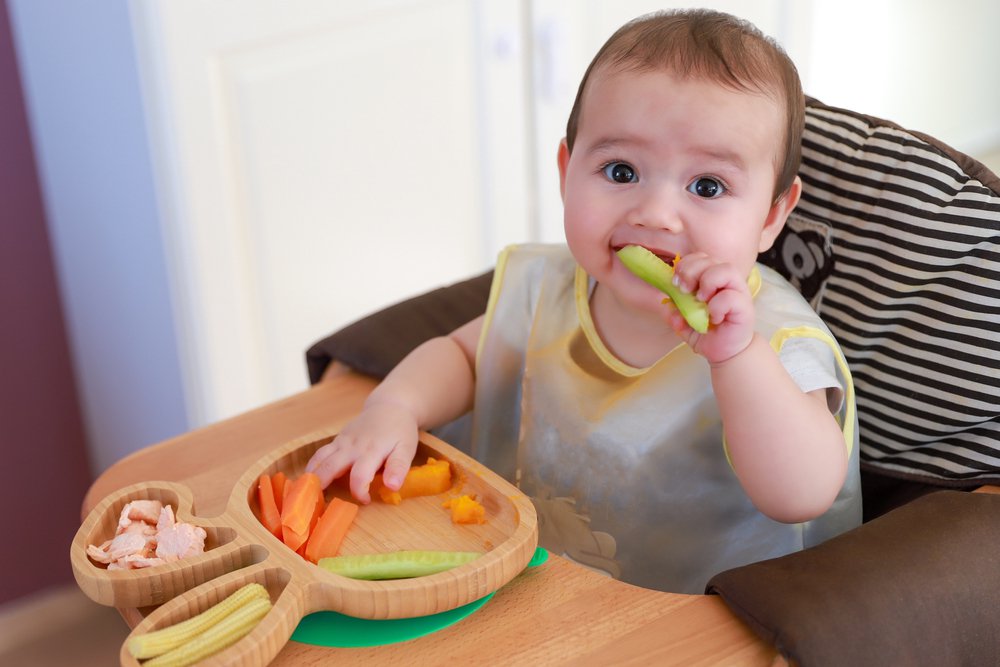 The main goal is to avoid forcing baby to take more bites than they want to, which can sometimes happen with purees.
The main goal is to avoid forcing baby to take more bites than they want to, which can sometimes happen with purees.
When to Introduce Potentially Allergenic Foods
In recent years, guidelines have been updated on when to introduce potential allergens including peanuts, eggs, and shellfish, so unless you have a family history of a food allergy, you can go ahead and introduce them soon after baby starts eating solids. In fact, research is showing that introducing these foods early can actually protect baby from developing an allergy. Talk to your pediatrician if you have concerns.
TIP: Thin unsweetened peanut butter with water to form a very thin Peanut Butter Puree until it’s about the consistency of regular yogurt and offer a very small amount on a spoon or spread on a toast stick.
What does a baby led weaning meal look like for months 7 and 8?
Until a baby is closer to 9 months and is able to pick up smaller pieces of foods, but after they have gotten the hang of one food at a time, I try to offer 1-2 foods they can feed themselves and one puree. This offers them a chance to ingest more via the puree but still feed themselves a range of textures. You can do more or less food following the lead of the child.
This offers them a chance to ingest more via the puree but still feed themselves a range of textures. You can do more or less food following the lead of the child.
TIP: My Baby Food Chart has loads of with ideas for blw foods and purees by month.
Recipes for Every Stage of Starting Solids
If you’re ready to start solids with baby, or you’re just curious what it looks like to do a mix of baby led weaning and purees, check out my Yummy Baby Food cookbook. It goes stage by stage with specific foods to start in each, with simple recipes and easy feeding tips.
Listen to a recent podcast episode to hear about some of the basics of BLW with our guest Megan McNamee, MPH, RDN, CLT, and a Registered Dietitian Nutritionist specializing in pediatric nutrition who runs Feeding Littles.
I’d love to hear any questions you have with BLW or if your baby had a first food that I didn’t list here. Please comment below to share your experience!
Prep Time 5 minutes
Total Time 5 minutes
Author Amy Palanjian
Cuisine American
Course Dinner
Calories 28kcal
Servings 1
Banana
- ▢ 1 small ripe banana with peel on
Roasted Sweet Potato
- ▢ 1 small sweet potato + 1 teaspoon olive oil
Roasted Apple
- ▢ 1 small apple + 1 teaspoon butter or neutral oil
Roasted Broccoli
- ▢ 1 cup broccoli florets + 1 teaspoon olive oil
Sauteed Green Beans
- ▢ 4 green beans 1 teaspoon olive oil
Melon
- ▢ 1 small piece watermelon or cantaloupe
Avocado Toast
- ▢ 1 slice whole grain bread
- ▢ 1 tbsp ripe avocado
Avocado Spear
- ▢ ⅛ ripe avocado
Lamb or Beef
- ▢ 1 lamb chop, roast, or steak
Pan-Seared Chicken Thighs
- ▢ 1 chicken thigh
- ▢ 1 tsp olive oil
- ▢ 1 garlic clove, optional
Banana with some of the peel still on
Cut a banana in half.
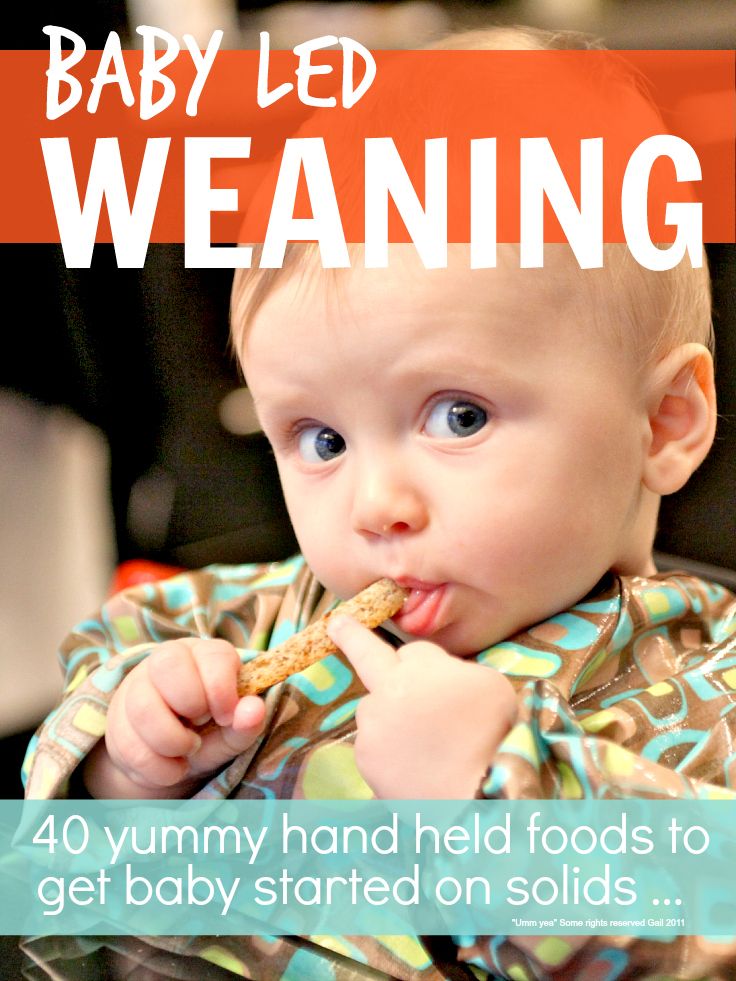 Use a knife to gently cut around the peel about 2 inches down, leaving some of the peel on so that the banana is easy for baby to hold and less slippery.
Use a knife to gently cut around the peel about 2 inches down, leaving some of the peel on so that the banana is easy for baby to hold and less slippery.
Roasted Sweet Potato Wedges
Preheat oven to 400 degrees and line a rimmed baking sheet with foil. Wash and dry the sweet potato. (You don't need to peel it.) Cut in half, then cut lengthwise into strips. Cut each strip in half again until each is about 1/2-inch thick. Slice in half horizontally if the sweet potato is very long. (Each strip should be about the size of your finger.) Place into a bowl and toss with the olive oil. Spread onto prepared baking sheet and roast for 22-25 minutes or until soft. Let cool slightly and serve.
Roasted Apple Wedges
Roasted Broccoli Florets
Preheat the oven to 400 degrees F. Place the broccoli onto a rimmed baking sheet and toss with the olive oil, coating and mixing well until all of the florets are a little shiny and coated with oil.
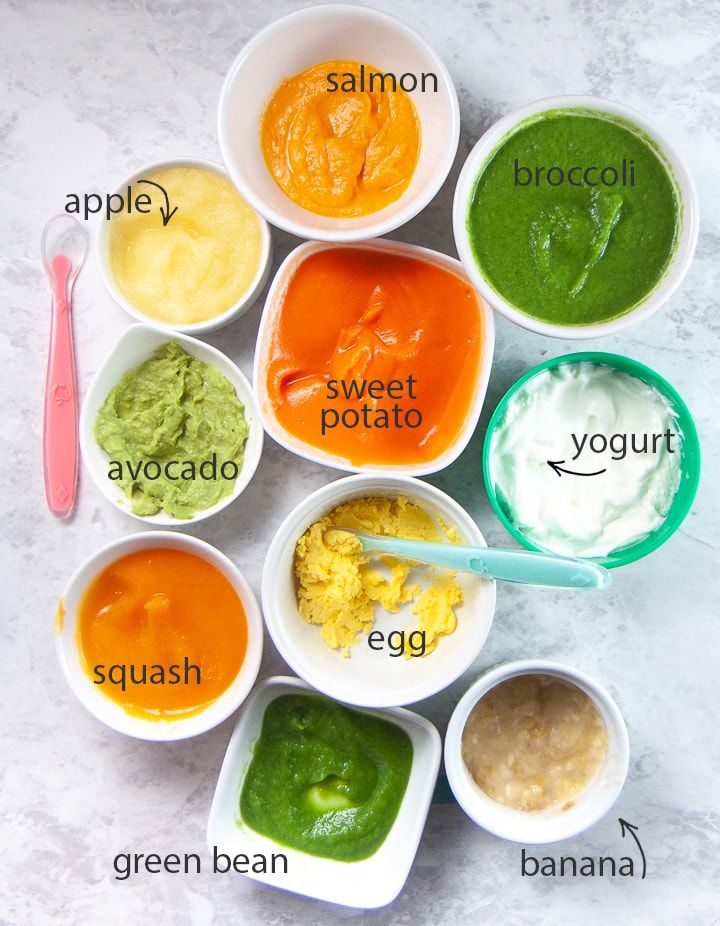 Roast for 15-18 minutes or until tender. Let cool slightly and serve.
Roast for 15-18 minutes or until tender. Let cool slightly and serve.
Sauteed Green Beans
Warm the oil in a large skillet over medium heat. Add the green beans and stir. Cover and cook for about 8 minutes. Remove cover and taste one to see if it’s soft enough. Cook for an additional minute or two as needed.
Melon slices
Avocado Toast
Avocado Spears
(Make sure the avocado is ripe and soft): Cut a thick strip of avocado and offer to baby. You can leave the peel on if that makes it easier for baby to hold (just wash it first).
Lamb or Beef
Prepare a roast, steak, or chop without salt and with butter or olive oil until cooked medium well. Offer a thick slice at least the size of your finger or a drumstick.
Pan-Seared Chicken Thighs
Warm 1 tablespoon olive oil or butter in a large skillet over medium heat. Add the chicken thigh and top with a few slices of fresh garlic, if desired.
 Cover and cook for 4-5 minutes. Remove cover. Flip over and cook for an additional 4-5 minutes uncovered or until a meat thermometer registers 165 degrees F.
Cover and cook for 4-5 minutes. Remove cover. Flip over and cook for an additional 4-5 minutes uncovered or until a meat thermometer registers 165 degrees F.
- Add spices like garlic powder, cinnamon, cumin, oregano, or any other non-spicy flavor you like to make these more interesting.
- Offer just one piece at a time when starting out.
- If baby gnaws a piece down into a smaller piece, replace it with a larger one to avoid her putting a chunk of food into her mouth.
- Store any leftovers in an airtight container in the fridge for 3-5 days. Reheat briefly if needed.
- Remember that it's normal for babies to take time to actually ingest the food. Part of the process is exploring all of the senses related to the experience of eating.
Calories: 28kcal, Carbohydrates: 2g, Protein: 1g, Fat: 2g, Saturated Fat: 1g, Polyunsaturated Fat: 1g, Monounsaturated Fat: 2g, Sodium: 6mg, Potassium: 75mg, Fiber: 1g, Sugar: 1g, Vitamin A: 23IU, Vitamin C: 2mg, Calcium: 2mg, Iron: 1mg
Tried this recipe?Rate in the comments and tag @yummytoddlerfood on IG!
Best Iron-Rich Foods for Babies, Toddlers, & Kids (+50 Recipes!)
Ensuring that our kids eat a well balanced diet, including iron-rich foods, can be hard when they’re eating unpredictably. I hope this info on iron-rich foods for kids (and the recipe ideas at the bottom) helps to set your mind at ease!
I hope this info on iron-rich foods for kids (and the recipe ideas at the bottom) helps to set your mind at ease!
Iron-Rich Foods
Ensuring that your kids are getting enough iron can seem hard when they’re in a phase of picky eating—or just not eating a ton. But since iron deficiency and iron deficiency anemia are still common issues with kids and it can impact their development and behavior, it’s important to try to include iron-rich foods in their daily meals.
For some context, according to the American Academy of Pediatrics, “Among children ages 1 to 3 years, iron deficiency occurs in 6.6 percent to 15.2 percent of toddlers, depending on ethnicity and socioeconomic status.” Which is much higher than I would have expected. They say that preterm infants, exclusively breastfed infants, and infants at risk of developmental disabilities are at higher risk for deficiencies.
I never want any parents to worry excessively about their child’s nutritional intake and thankfully, adding iron to a diet is actually quite easy.
(My favorite iron-rich recipes include Spinach Muffins, Extra-Veggie Baby Pasta, Oatmeal Bars, Meatballs, Chicken Puree, Butter Chicken, Chicken Tacos and Spinach Eggs. For more, scroll down.)
How much iron does my child need?
Toddlers ages 1 to 3 years need 7 mg/day of iron. Kids aged 4-8 need 10 mg/day. For context:
- ¾ cup of Cheerios: 6 mg
- 1 serving fortified infant oatmeal: 5 mg
- 4 ounce hamburger: 5 mg
- 2 ounces Banza chickpea pasta: 4 mg
- ½ cup dried peaches: 3.2 mg
- 2 ounces Barilla red lentil pasta: 3 mg
- ½ cup of lentils: 3 mg
- 1 cup prune juice: 3 mg
- Spinach Quesadilla: 2.1 mg
- ½ cup dried apricots: 1.7 mg
- ½ cup oatmeal: 1.7 mg
- Simple Green Smoothie: 1.7 mg
- Spinach Banana Muffin: 1.4 mg
- 1 egg: 1.4 mg iron
- ½ cup raisins: 1.5 mg
- 1 slice whole wheat bread: 0.7 mg
- ½ cup fortified baby puffs: 0.7 mg
- 1 ounce hummus: 0.7 mg
- 2 tbsp peanut butter: 0.
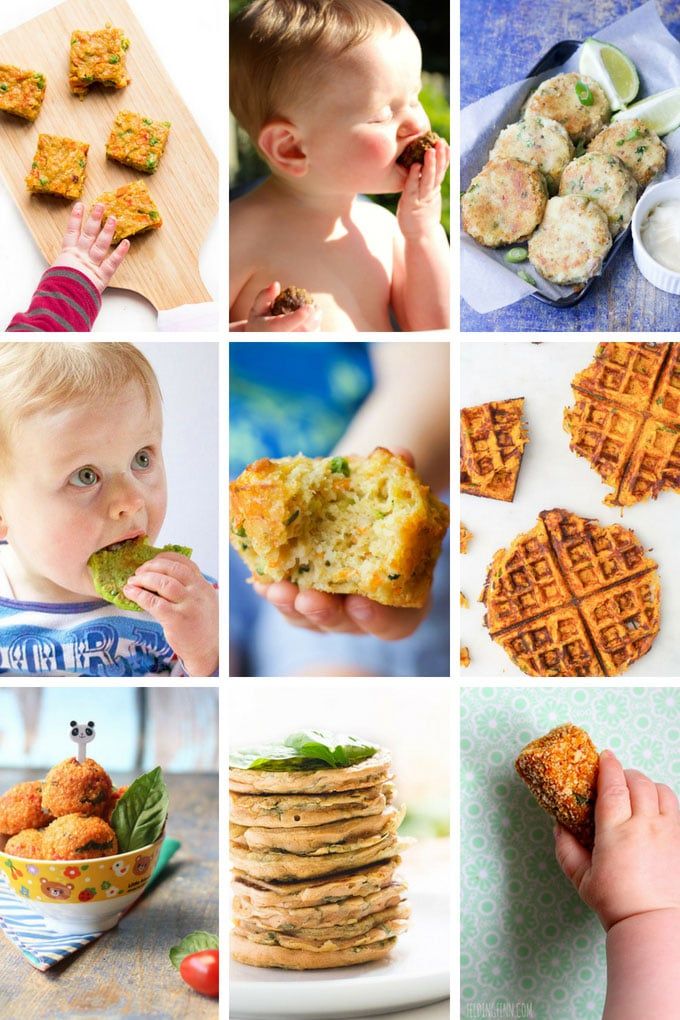 6 mg
6 mg - ½ cup edamame beans: 0.5 mg
- 1 cup watermelon: 0.4 mg
TIP: It’s possible that your kiddo is already getting enough just by eating normal toddler-size servings.
Does my child need an iron supplement?
This question will vary a lot by child so it’s best to check in with your doctor. Kids are routinely screened for iron deficiency when they’re babies and toddlers, so definitely discuss this with your pediatrician if you don’t remember what those results were, if your child is older, or if you’re just curious about supplementing.
It can be hard to find a multivitamin with iron, so check your label, or consider a separate iron supplement in consultation with your doctor.
What are the best sources of iron for kids?
The AAP recommends that iron comes from iron-rich foods first and foremost. The type of iron in meat, fish, and poultry is easier for our bodies to absorb, but adding a range of iron-rich foods is your best bet. Here are some examples of foods with a good dose of iron.
Here are some examples of foods with a good dose of iron.
- Red meats like beef and lamb
- Dark meat poultry
- Fish including shrimp and oysters
- Iron-rich vegetables including dark leafy greens (think Popeye!), baked potatoes, and pumpkin
- Beans and legumes like kidney beans, lentils, and tofu
- Fortified cereals like Cheerios and some hot cereals including baby oatmeal
- Whole grains and whole grain products (including some of the newer bean pastas like Banza)
TIP: A toddler-size serving of meat is 2 tablespoons to ¼ cup. A toddler-size serving of produce is 2 tbsp to ¼ cup. A serving of beans and legumes is 1-2 tablespoons for younger kids and ¼ cup for older kids. (Find more specifics in my Daily Toddler Nutrition Guide.)
Top 10 Best Iron-Rich Foods for Babies
Here are my go-to foods with a lot of iron that you can feed to a baby who’s eating purees or baby led weaning style foods.
- Beef, ground
- Bean puree
- Beans, very soft and lightly mashed
- Bean pasta, cooked very soft (like Banza)
- Chicken, finely shredded or ground or Chicken Puree
- Eggs, scrambled or Egg Yolk Puree
- Green bean puree
- Infant cereal like baby oatmeal, fortified
- Oatmeal
- O cereal
- Smoothies with spinach or kale (serve on a spoon or in a reusable pouch)
- Sweet potatoes, mashed
- Pea puree
- Peanut butter puree
- Strawberry puree
TIP: Iron stores in babies start to run out starting around 6 months, so you’ll want to incorporate these foods into your baby’s diet from an early age.
Top 15 Best Iron-Rich Foods for Toddlers and Big Kids
These foods are easy to prepare and packed with iron for kids.
- Apricots, dried
- Beans
- Bean pasta (like Banza with marinara sauce)
- Beef burgers
- Broccoli
- Eggs
- Green beans
- Oatmeal
- Peanut butter
- Raisins
- Smoothies with spinach or kale
- Spinach Pesto
- Strawberries
- Watermelon
- Wheat bread
TIP: Aim to serve 2-3 of these foods (from either the baby or toddler list) most days and you should easily provide enough opportunities for your child to eat enough iron.
Add Vitamin C for Increased Iron Absorption
If you pair iron-rich foods with produce with plenty of Vitamin C—think citrus, strawberries, kiwi, tomatoes, dark greens, and bell peppers—the iron will be more readily absorbed by the body. Some ideas to consider:
- Pasta with Meatballs (Vitamin C from tomatoes, iron from beef)
- Bean Burritos with salsa (iron in beans, Vitamin C from salsa)
- Bean Quesadillas with chopped tomatoes on the side (iron in beans and whole grain tortilla, Vitamin C from tomatoes)
- Simple Green Smoothie (iron from greens, Vitamin C from fruit)
- Spinach Banana Muffins with Banana with kiwi (iron in spinach, Vitamin C from kiwi)
Limit Milk to No More than 24 Ounces Each Day to Avoid Limiting Iron Absorption
Experts at the Mayo Clinic also advise against letting the kids have more than 24 ounces of milk in a day (or three 8 ounce servings) which could negatively impact iron absorption. That much milk could also make them less hungry for other foods, which could also limit how much iron they’re able to eat through foods.
That much milk could also make them less hungry for other foods, which could also limit how much iron they’re able to eat through foods.
50 Best Iron-Rich Recipes for Babies, Toddlers, and Kids
Here are some of my favorite recipes for kids of all ages that are rich in iron. (The list is organized alphabetically for easy reference, not in order of preference!)
- Bean Puree
- Bean Pasta with Marinara Sauce
- Beef Burritos with Veggies
- Black Bean Quesadillas
- Black Bean Soup with Citrus
- Broccoli Pesto
- Broccoli Cheddar Soup
- BBQ Shredded Chicken
- Cheesy Meat Buns
- Chicken Meatballs with Sweet Potato
- Chocolate Smoothie with Hidden Veggies
- Green Smoothie
- Kale Bites
- Lentils and Rice with Dried Fruit
- Lentils with Tomatoes and Italian Spices
- Lentil Soup with Veggies
- Lentil Falafel
- Meatballs with Hidden Veggies
- Mini Egg Muffins
- Mexican Egg Muffins with Spinach
- Moroccan Lamb Meatballs
- No-Bake Energy Bites
- Nut-Free Hummus
- Oatmeal with Apple and Raisins
- Oatmeal Bars
- Oatmeal with Pumpkin
- Pesto Chicken and Brown Rice
- Potato Nachos
- Pumpkin Oatmeal Bars
- Pumpkin Oatmeal Muffins
- Slow Cooker Chicken and Bean Tacos
- Slow Cooker Black Bean Soup
- Slow Cooker Chicken Tacos
- Spinach Banana Muffins with Banana
- Spinach Pancakes
- Spinach Eggs
- Spinach Pesto
- Spinach Quesadillas
- Strawberry Puree
- Strawberry Smoothie
- Strawberry Muffins
- Sweet Potato Quesadillas
- Sweet Potato Baby Food
- Tofu Nuggets
- Tofu, Baked
- Tofu with Sesame
- Whole Wheat Bread
- Veggie Chili
- Veggie Chili Mac
- Zucchini Burgers
Printable Iron-Rich Foods List
For easy reference, you can print this list of iron-rich foods for kids keep in your kitchen, or save the image on your phone. Simply sign up for my newsletter and gain access to my entire FREE Resource Library of printables.
Simply sign up for my newsletter and gain access to my entire FREE Resource Library of printables.
Related Recipes
I’d love to hear if iron has been an issue for you with your kids. Chime in below in the comments!
table of the introduction of the first complementary foods by months, input scheme, the correct menu of the child on the IV, what can be given to the artificial
Contents: Hide
Formula-fed complementary foods
Inexperienced mothers of newborn babies are concerned about many problems: fighting colic, establishing a daily routine, performing hygiene procedures. However, time goes by and acute issues gradually become irrelevant. Inexorably, a new crucial stage is coming - the introduction of the first complementary foods begins. We will tell you how to properly introduce complementary foods with artificial feeding.
Inexorably, a new crucial stage is coming - the introduction of the first complementary foods begins. We will tell you how to properly introduce complementary foods with artificial feeding.
Why does a baby need complementary foods
Both natural and bottle-fed babies are usually equally full of energy, active and inquisitive. The introduction of complementary foods allows you to gradually accustom the baby's gastrointestinal tract to new food, as well as give the growing body the vitamins and minerals that it needs at a particular stage of physical development. Also, with its help, you can gradually adapt the baby to the diet of adult family members and then painlessly transfer it to the common table. There are no exact norms and rules for the introduction of complementary foods. It is necessary to focus on the needs of the child and follow the recommendations of the pediatrician.
When can complementary foods be introduced with artificial feeding
Teaching children to adult food should be timely. The fact is that the gastrointestinal tract of an infant at a too early age (for example, 2-3 months) is not able to process certain foods. The mucous membrane of the digestive system is irritated, and this can provoke gastritis and other serious health problems.
The fact is that the gastrointestinal tract of an infant at a too early age (for example, 2-3 months) is not able to process certain foods. The mucous membrane of the digestive system is irritated, and this can provoke gastritis and other serious health problems.
IMPORTANT! At what age can you introduce your baby to new products? For children in good health, WHO recommends that complementary foods be introduced at 6 months of age. But for some babies, if there are certain medical indications, the doctor may advise you to do this earlier.
The recommendations do not provide a specific menu for each age, which must be followed. Much depends on the socio-cultural characteristics of different peoples and the individual pace of development of children. In most cases, the timing of the start of complementary foods varies from 4.5 to 6 months. Specialists distinguish the following signs of a child's readiness to try something new, in addition to the usual artificial mixture:
• the baby is not quite full of the mixture and asks to continue the meal;
• his first teeth have already erupted, he tries to chew them, takes and tries to taste food from adult plates;
• if you bring a spoon to the baby, he will begin to examine its contents and want to try it;
• the child sits confidently, can turn his head and control his body;
• The tongue thrust reflex fades so baby can drink water from a spoon without it dripping back out.
It is not necessary that all of the listed features be present at once. If several of them are observed, then it is quite possible to try to introduce the first complementary foods.
Read also: How much does a newborn eat per feeding?
When to delay feeding
It is better to delay feeding if:
• the child is ill;
• less than three days have passed since vaccination;
• the baby is teething, he does not sleep well and is naughty;
• there have been some changes in the family's lifestyle, such as moving to a new home, mother going to work, traveling to another city or country;
• the crumbs have manifestations of allergies, upset of the gastrointestinal tract;
• The weather is too hot outside.
Therefore, complementary foods should only be offered to a child when he is completely healthy, calm and in a good mood.
Basic rules for the introduction of complementary foods
Anna Levadnaya, pediatrician, Candidate of Medical Sciences, explains that the principles of introducing complementary foods on natural and artificial feeding are similar: it is recommended to focus on food interest, signs of a child's readiness for introducing complementary foods. The only thing is that with exclusive breastfeeding, it is not recommended to supplement the child with water, while bottle-fed children can be offered water.
The only thing is that with exclusive breastfeeding, it is not recommended to supplement the child with water, while bottle-fed children can be offered water.
Video: 10 rules for complementary foods
Author: pediatrician, Ph.D. Komarovsky E.O.
The rest of the principle is the same: for both breastfeeding and formula-feeding, offer your baby a new food before feeding, and then supplement with breast milk or formula.
In order for new products to bring benefits to the baby on artificial feeding and not harm his health, you should follow a number of simple recommendations.
1. Complementary foods are usually given in the morning before the main formula feeding. This allows you to track the reaction to unfamiliar food during the day and take action if necessary.
2. It is necessary to carefully monitor the cleanliness of children's dishes, pots and blenders. The gastrointestinal tract of an infant is very sensitive to infectious agents.
It is necessary to carefully monitor the cleanliness of children's dishes, pots and blenders. The gastrointestinal tract of an infant is very sensitive to infectious agents.
3. New food is introduced into the baby's diet from a quarter of a teaspoon. If he tolerated the product well, then within a week the portion is brought to one or two tablespoons. Then you should look at the desire of the child and his well-being, and also take into account the recommendations of the pediatrician.
4. The first dishes should be of a liquid consistency, then they are made into a puree, and only closer to a year can you give soft pieces to chew. Pediatricians advise adding butter and vegetable oils to them as vegetables and cereals are introduced into the diet.
5. In order to protect the child's body from pathogens that may be contained in unprocessed food, complementary foods should first be boiled, stewed or baked. The baby is offered slightly warm food: the optimum temperature is 36-37 degrees.
6. It is advisable to try the products immediately from a spoon. If the baby gets used to the bottle, this will slow down the formation of the skill of chewing food and may subsequently affect diction.
7. A food diary can help you reliably identify what your child has an allergic reaction to. It should record everything that the baby ate during the day, in what quantity and at what time. You can also record in a diary whether he liked the new dish or not.
8. Complementary foods should be introduced only from mono-products. Only after making sure that vegetables, cereals, juices, fruits or protein products are well tolerated by the child, you can offer their mixes.
9. The interval between introduced and new complementary foods should be at least a week. Such a period of time will allow the child's body to adapt to the expanded diet and perceive other dishes without unpleasant surprises.
10. If an allergy occurs to any product, it should be immediately removed from the menu and consulted by a pediatrician. It will be possible to return to this complementary food no earlier than in a month.
It will be possible to return to this complementary food no earlier than in a month.
11. It is desirable that with the introduction of complementary foods, the infant receives a sufficient amount of liquid. It can be both ordinary water and compotes.
12. Do not offer your child foods that are considered highly allergenic as first foods: full-fat cow's milk, citrus fruits, gluten-containing cereals, chicken eggs, etc.
13. Do not force-feed a child, even if you think that he is hungry. A small person has the right to defend his opinion in the choice of dishes.
14. Feed your baby exclusively in a sitting or reclining position to avoid the risk of aspiration. Very convenient for this purpose are special highchairs made of easy-to-clean material.
From 7–8 months, formula-fed mashed or pureed food, such as a banana, can be used as complementary foods. If semi-solid food is not introduced into his diet in time, problems may arise with the intake of solid food in the future: after a year, the child will refuse it completely. From 8–9 months, the child should be offered the so-called finger food: cut soft fruits and vegetables into pieces, such as boiled carrots, potatoes, and offer them to the baby. If you follow this scheme, by the year the child will be ready to eat solid food from the common table, Levadnaya explains.
From 8–9 months, the child should be offered the so-called finger food: cut soft fruits and vegetables into pieces, such as boiled carrots, potatoes, and offer them to the baby. If you follow this scheme, by the year the child will be ready to eat solid food from the common table, Levadnaya explains.
Complementary Feeding Schedule
We provide a suggested complementary feeding schedule for up to a year to guide you unless advised otherwise by your doctor. As a standard formula-fed babies with normal weight gain are offered products in approximately the following order:
• vegetable puree;
• cereals;
• fruit puree;
• kefir;
• butter and vegetable oil;
• children's biscuits and bread;
• meat puree;
• fish puree.
The earlier introduction of vegetable puree rather than fruit puree is due to the fact that the former has a more insipid taste. Having fallen in love with sweet apples and bananas, the child may subsequently refuse to eat zucchini, pumpkin, etc.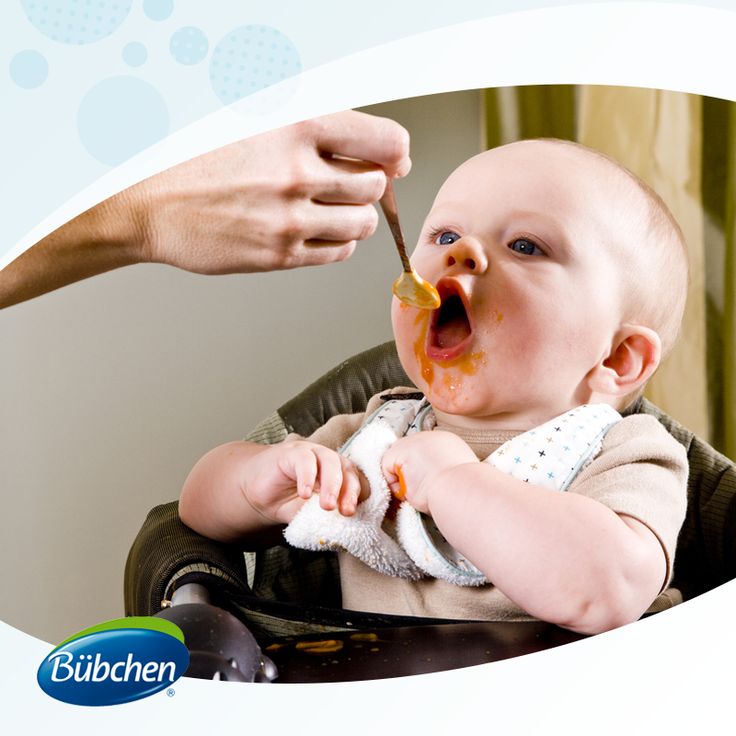 However, if the infant is underweight, the doctor may recommend porridge as the first complementary food for him. They are more high-calorie and allow you to gain the missing kilograms faster. Each type of complementary food is described in the table.
However, if the infant is underweight, the doctor may recommend porridge as the first complementary food for him. They are more high-calorie and allow you to gain the missing kilograms faster. Each type of complementary food is described in the table.
| Vegetables | They are usually offered to children in the following order:
Tomatoes, white cabbage and cucumbers are recommended to be included in the menu already after a year. |
| Fruit | Seasonal fruits are recommended. The approximate order of their introduction: apples, pears, peaches, apricots and bananas. If the baby suffers from constipation, you can carefully and with the permission of the pediatrician offer him plums. |
| Kashi | To start complementary foods, choose gluten-free cereals: buckwheat, rice, corn grits. After the child is 8 months old, you can gradually give him a taste of oatmeal, wheat and barley porridge. It is better to refuse semolina altogether, since it contains very few useful substances and at the same time it is very high in calories. Cereals can be ground in a coffee grinder or mashed from ready-made cereals in a blender. |
| Protein products | Fermented milk products do not need to be introduced earlier than 8 months, since only by this time do children begin to produce the enzymes necessary for their processing. From meat, children under one year old should be given rabbit, chicken, turkey and veal. Sea fish is more suitable - hake, cod or flounder. Meat and fish are offered to kids in grated form as part of vegetable dishes and cereals. Cottage cheese can be prepared for the baby yourself. |
IMPORTANT! It is undesirable to add salt, sugar and spices to food for a child. His taste buds are not yet accustomed to strong stimuli, so it is better for him to appreciate the natural taste of the food offered. Soup should be boiled only on vegetable broths, and meat should be added to an already prepared dish. Meat broth may be too heavy for the baby's kidneys.
How to choose complementary foods
The main recommendations for choosing specific foods to start complementary foods are as follows:
1. It is recommended that your baby's diet be based on products grown in the region where he/she lives. If the period of the first feeding falls on the winter, it is advisable to stock up vegetables, fruits and berries from your garden in advance, putting them in the freezer for safekeeping. In the event that this is not possible, you can give preference to ready-made canned mashed potatoes. They undergo mandatory certification confirming the quality.
In the event that this is not possible, you can give preference to ready-made canned mashed potatoes. They undergo mandatory certification confirming the quality.
2. It is advisable not to buy store-bought juices for your child in large quantities. Compotes will be much more useful for him. You can also offer decoctions of dried fruits.
3. If you decide to buy ready-made food for your baby, then pay attention to the label and the release date. The product must be age appropriate and fresh. The composition should not contain salt, sucrose, dextrose and other extraneous additives.
In general, it is worth remembering that the first food offered to a child should be puree-like, not too viscous products, consisting of one ingredient, soft consistency, without added sugar, salt and spices, says Andrey Mosov, head of the expert direction of NP Roskontrol, doctor on nutritional hygiene of children and adolescents. He insists that preference should be given to industrial prepared meals, as such products have been tested and certified. There are no guarantees with mashed homemade vegetables.
There are no guarantees with mashed homemade vegetables.
Introduction of complementary foods to formula-fed premature babies
The question of the correct introduction of complementary foods to a premature baby should be discussed individually at a pediatrician's appointment. In order for the body to be able to process a new product, organs and systems must be sufficiently mature and prepared. The quality of food digestion largely depends on the production of special enzymes, so you should not be self-motivated in compiling the baby's menu.
The schedule for the introduction of complementary foods will be determined by the presence or absence of anemia, the rate of weight gain, the tendency to allergies, and some other nuances. Formula-fed premature babies are usually advised to start introducing meat and egg yolk earlier. It is advisable to cook porridge on a vegetable broth or mixture, and not on water, since then they will be more nutritious and healthy.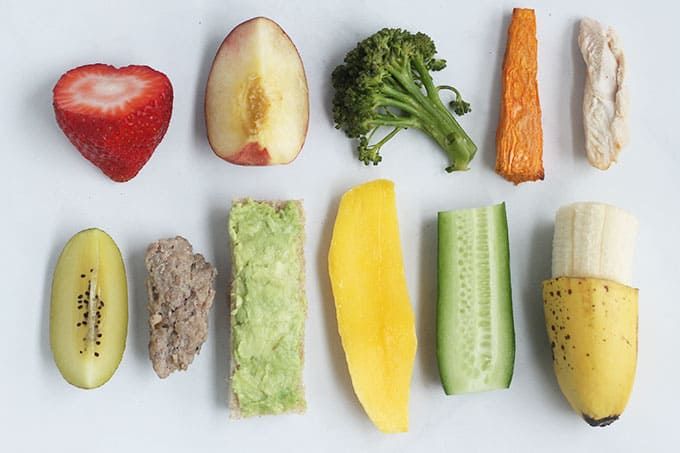
IMPORTANT! However, the course of complementary foods must be monitored by a pediatrician. The doctor monitors the child's reaction to new products, evaluates the dynamics of growth and general physical development. The scheme may change if any deviations from the norm are detected during routine inspections.
Answers to frequently asked questions for mothers
• What foods should not be given to babies under one year old?
It is forbidden to give cow's milk to babies under the age of one, as it can cause allergic reactions and digestive disorders. It is perfectly replaced by adapted mixtures from modern manufacturers. In addition to milk, it is not recommended to include nuts, citrus fruits, exotic fruits and vegetables, red fish and honey in the menu of the crumbs of the first year of life.
• What should I do if my child absolutely does not want to eat complementary foods?
Wait a while and try to offer food again, but don't insist on another refusal. Perhaps the baby did not like the new dish because of the unfamiliar taste. Children are big conservatives and are often wary of change. Be patient, do not rush to introduce complementary foods. Show your child with what appetite you yourself eat from your plate, and then he may have a desire.
Perhaps the baby did not like the new dish because of the unfamiliar taste. Children are big conservatives and are often wary of change. Be patient, do not rush to introduce complementary foods. Show your child with what appetite you yourself eat from your plate, and then he may have a desire.
• What should I do if my baby has problems with stool while weaning?
If a child has a stool retention of more than three days during the introduction of complementary foods, then we can talk about constipation. In this case, you need to visit a pediatrician, as well as immediately exclude fixing foods from the menu and give more fluids to drink. If the stool has become too frequent (more than 5 times a day), then this may be due to indigestion or an intestinal infection. Be sure to consult your doctor about this.
• What should I do if I have an allergy to complementary foods?
It is advisable to take care of this issue even before the introduction of complementary foods, asking the pediatrician observing the child to prescribe an antihistamine drug that is optimal for his age. You should also carefully fill out the food diary at first. With it, it will be possible to identify a possible allergen and exclude it from the baby's menu, preventing more serious health consequences.
You should also carefully fill out the food diary at first. With it, it will be possible to identify a possible allergen and exclude it from the baby's menu, preventing more serious health consequences.
• How do you know if a baby tolerates complementary foods well?
Normal weight and height gain, regular bowel movements, and the absence of allergic skin rashes indicate the successful introduction of complementary foods. If the baby is cheerful, active, he has a good appetite and a good sleep, most likely, this means that you are doing everything right and the selected diet suits him.
However, it is impossible to completely refuse artificial formula when introducing complementary foods, even when the infant eats complementary foods with appetite. His body is not yet ready for a complete change in the type of food and may malfunction. This often manifests itself in the form of allergies, stool disorders or growth retardation. Remember that the baby should enjoy the new food.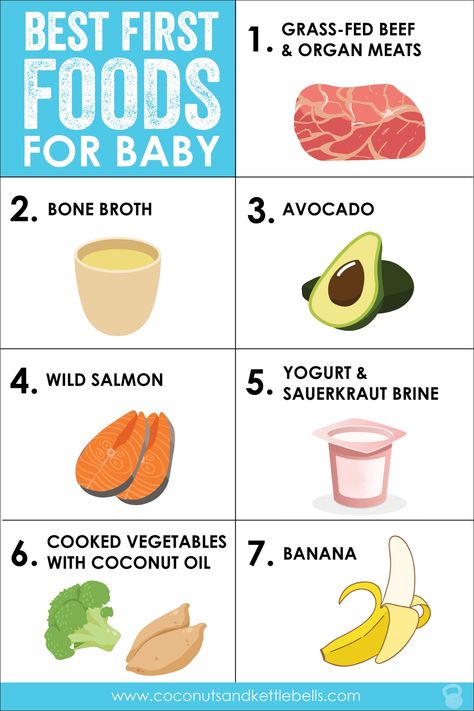 Only under this condition will he form the correct eating behavior.
Only under this condition will he form the correct eating behavior.
#Nutrition for children up to a year #Complementary food
Complementary foods menu: what is better to give in the morning, afternoon and evening
Kizino Polina Aleksandrovna
pediatrician, perinatal psychologist
What foods to start complementary foods with and how to diversify the diet of a child up to a year? Healthy baby food menu and recommendations for baby food.
— Polina Alexandrovna, please tell us what complementary foods are.
— Complementary foods can be described as a way to transition from milk feeding (breastfeeding, mixed feeding or artificial feeding) to "adult" food, which the child will consume after some time from the common table.
— When to start complementary foods, what recommendations do doctors give?
- There are several recommendations for the introduction of complementary foods:
- World Health Organization (WHO) - from about 6 months.

- of the Union of Pediatricians of Russia, more adapted to our environment - from 4-6 months.
Complementary foods are introduced more often:
- from 5 months - when the child is fine
- from 4 months - with obvious deficient conditions
Important! "Hypoallergenic corridor" - a period from 4 to 7 months, during which you can enter the maximum number of products with the lowest risk of allergies in the baby.
Try MAMAKO ® baby food with goat milk - delicate cereals, cream soups and purees with fruits and vegetables to expand your baby's diet.
— Polina Alexandrovna, how can a mother correctly compose a child’s menu during the day?
— When a mother is just starting to introduce a new food to a child, it must be taken into account that there is always the possibility of developing allergic reactions. Even if hypoallergenic foods are given, it is important to check how the child reacts to them.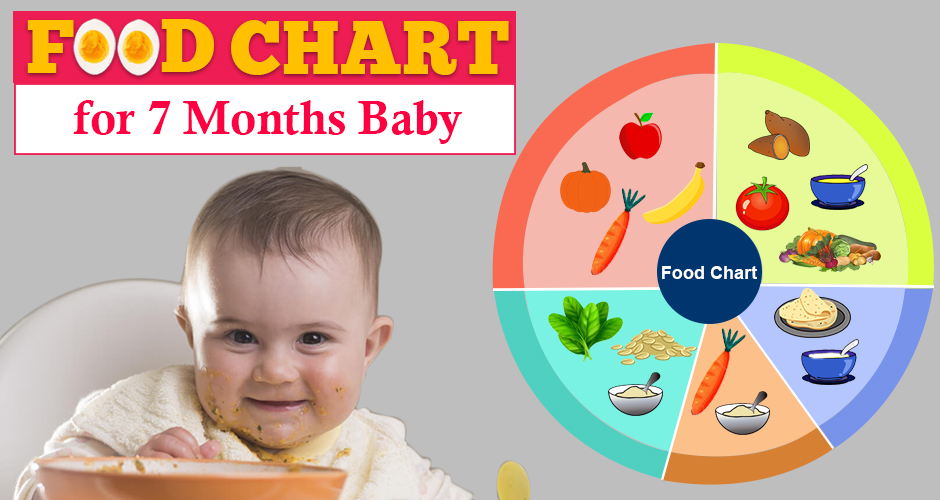 Therefore, it is advisable to give new products in the morning in order to have time to track the reaction that may occur in the child.
Therefore, it is advisable to give new products in the morning in order to have time to track the reaction that may occur in the child.
- What foods can be included in the morning baby food menu?
- If we talk about complete complementary foods (the baby is already familiar with different types of food), then in the morning we will most likely give the baby porridge. Porridge contains carbohydrates and other nutrients, gives the child a supply of energy and strength to actively start the morning, and during the day to maintain activity, allows you to play calmly, without feeling hungry.
— What to give to a baby during the day?
- If this is the first and second complementary foods, then, most likely, the child will receive only vegetables for lunch. Over time, the baby's diet expands, he additionally receives dairy and meat products. For a daily meal, you can consider cream soups from MAMAKO ® with vegetables in goat's milk, so that lunch is as complete as possible in its composition.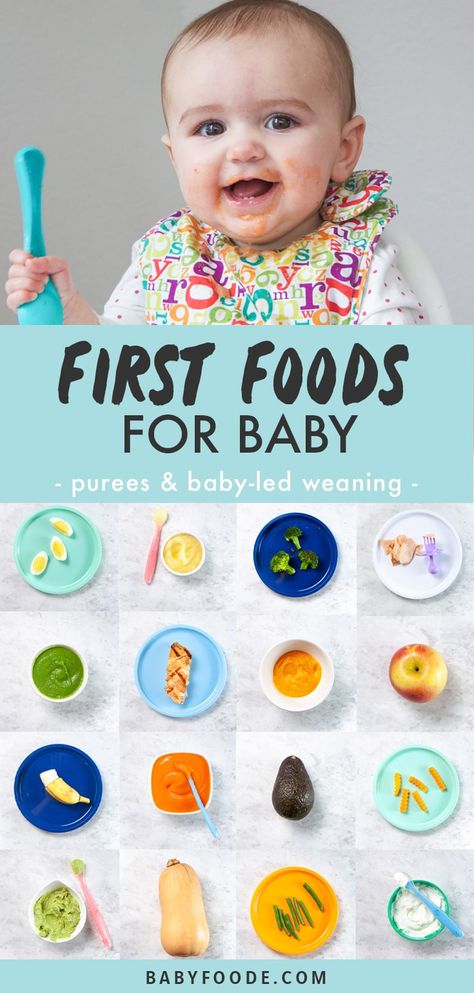
Cream soups MAMAKO ® are the only children's cream soups based on goat's milk. They do not require cooking and help to diversify the baby's vegetable complementary foods. Soups MAMAKO ® is 100% natural vegetables, the benefits of goat's milk and a delicate creamy taste.
— What complementary food is better to give the baby for an afternoon snack and what to feed him in the evening?
- In the evening, you should try to give lighter food so as not to overload the child - vegetables or fruit puree. You can supplement it with cottage cheese or other dairy product.
If the child does not tolerate the breaks between night feedings and often asks for food at night, it is sometimes acceptable to give porridge at night (including milk porridge if it is age appropriate).
— Why is it better to give your child different foods?
- At some point, the child will begin to consume adult food. And the sooner his mother starts to introduce him to different textures and products, different forms and presentation, the faster he will get used to it and it will be easier to switch to the “adult” table. If a child gets used to eating only mashed potatoes and liquid foods, then diversifying his diet is already quite difficult (the child will not be interested, he will continue to eat only mashed potatoes - this is easy and no effort is needed).
— At what age is it better to diversify complementary foods for a child?
— From the very beginning of the introduction of complementary foods, we try to diversify it. If vegetables are introduced as the first complementary food, then the baby will try two or three vegetables. If porridge is introduced second, then first he will try one porridge, then the second, the third. To say that diversity begins at a certain age is rather difficult, it begins from the first weeks of introducing complementary foods to a small child.
Advice to mom: the older the child becomes, the more varied and intense new foods should appear in his diet in order to reduce the risk of allergies to them in the future.
- Assortment of porridges for complementary foods MAMAKO ® .
A variety of cereals helps to choose a product that meets the needs of the child in the initial stages of the introduction of complementary foods and the stage of expansion of nutrition. For example, for a younger child, this is porridge with goat milk from one cereal, to expand the diet - porridge from seven cereals, cereals with the addition of fruits and berries. - The benefits of goat milk for the first feeding.
Goat's milk, unlike cow's milk, has a lower potential risk of developing allergies. And if you choose between goat's and cow's milk, it is better to prefer goat's milk cereals to minimize the risk of allergies in a child.
When you first introduce your child to new foods, try to introduce them to the child's diet in the morning to monitor the reaction. After the child has become acquainted with some products, you can distribute them throughout the day. This is done so that during the day the child has enough energy to play and develop, to be in a good mood, and in the evening not to overload the gastrointestinal tract. Then your baby will fall asleep comfortably and sleep throughout the night.
After the child has become acquainted with some products, you can distribute them throughout the day. This is done so that during the day the child has enough energy to play and develop, to be in a good mood, and in the evening not to overload the gastrointestinal tract. Then your baby will fall asleep comfortably and sleep throughout the night.
* Breast milk is the best food for babies. WHO recommends exclusive breastfeeding for the first 6 months of a child's life and continued breastfeeding after complementary foods are introduced until the age of 2 years. Before introducing new products into the baby's diet, you should consult with a specialist. The material is for informational purposes and cannot replace the advice of a healthcare professional. For feeding children from birth.
#Food #oatmeal
Baby's first porridge
#Complementary food
Expert MAMACO ®
When to start complementary foods.


 This will require pasteurized milk 2.5% fat and sourdough. After the milk turns sour, it is placed in a water bath and heated over low heat until the whey leaves. Then it remains only to drain the liquid through a colander or gauze and grind the resulting curd to make it more tender.
This will require pasteurized milk 2.5% fat and sourdough. After the milk turns sour, it is placed in a water bath and heated over low heat until the whey leaves. Then it remains only to drain the liquid through a colander or gauze and grind the resulting curd to make it more tender. 
